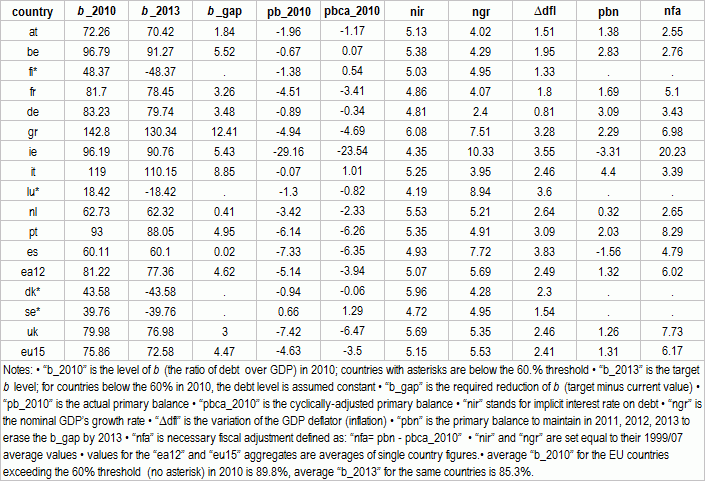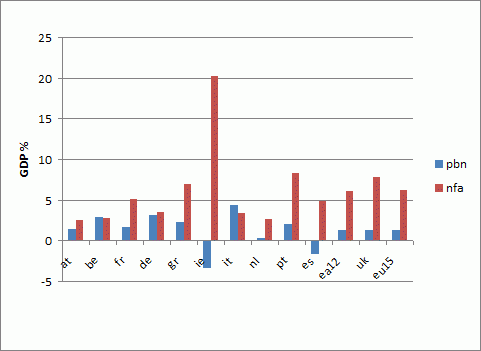In March 2011, the EU countries agreed on the rules for stronger EU economic governance. Debt levels and trajectories will now be a criterion in the assessment of public finances in the context of the Excessive Deficit Procedure (EDP). In particular, “Member States with debt in excess of 60% of GDP must reduce the amount by which their debt exceeds the threshold by at least 1/20th per year over three years. If they do not, they will be placed in EDP” (ECFIN 2011).1
If the rule becomes operational in 2011, its application for the period 2011–13 would require the countries with debtabove the 60% Maastricht-limit to reduce their debt/GDP ratio by an average amount of 4.47% (see Table 1 below).The countries with a gap (difference between the current and target level ) above the EU15 average turn out to be Greece (12.4%), Italy (8.8%), Belgium (5.5%), Ireland (5.4%) and Portugal (4.9%).
Conventional reduction of debt is feasible through primary surpluses which erode the debt year after year. Then, it becomes relevant to consider the necessary primary balance, and the linked necessary fiscal adjustment, to achieve the 2013 debt target for the countries exceeding the 60% threshold. The necessary primary balance depends on the interest rate, inflation, and growth scenario which the EU countries will face. We envisage a scenario in which these parameters are set equal to their 1999-2007 average (euro period without crisis). Primary balances to achieve the 2013 debt target are in Table 1. The necessary fiscal adjustment is equal to the difference between the necessary primary balance and the current stance (as defined by the cyclically-adjusted primary balance, Cottarelli et al 2010).2
Necessary fiscal adjustment
The average (yearly) necessary primary balance for the EU15 countries to achieve the 2013 target is +1.3% of GDP; the average necessary fiscal adjustment for the same countries is 6.2% of GDP. The large difference between these two figures depends upon the bad 2010 fiscal stance which requires a large correction from 2010 to 2011 (Figure 1). If such primary-balance value is maintained during 2011–13, the average debt for the countries exceeding the 60.0% threshold will decrease from 89.8% to 85.3%.
Table 1. Debt reduction for 2011/13
From the Table, it emerges that Belgium needs to reduce its debt/GDP ratio of 5.5% by 2013. This requires a yearly primary balance equal to +2.8%. Belgium’s fiscal stance in 2010 is sound, as shown by Belgium’s +0.07 primary balance (cyclically adjusted). Then, its fiscal adjustment from 2010 to 2011 is only 2.7%. Interestingly, even though Belgium’s debt gap is higher than Germany’s (5.42% against 3.48%), Germany’s primary surplus needs to be higher than Belgium’s because of a supposedly higher nominal growth in Belgium than in Germany.
Greece’s necessary primary balance amounts to +2.3%; such a low value is due to high nominal growth and inflation in the period 1999/2007. The necessary fiscal adjustment is much higher though, due to Greece’s large deficit (-4.7%).
Italy is the country which will have to commit more on the primary-balance side with a necessary primary balance equal to +4.4%. However, since its 2010 fiscal stance is sounder than other countries’, its fiscal adjustment is contained to 3.4%.
Ireland’s necessary fiscal adjustment (20.23%) reflects the extraordinary events in 2010 which have taken Ireland’s deficit to -29.1%.3 This figure can be therefore misleading for 2011 onwards.
Portugal would need to reduce its debt by 5.0% by 2013, starting from a 93.0% level in 2010. This requires a limited yearly primary balance equal to +2.0%. However, Portugal’s fiscal stance is very negative in 2010 as shown by a structural deficit reaching -6.2%. Its fiscal adjustment from 2010 to 2011 then amounts to 8.2% of GDP.
Figure 1. Necessary primary balance versus fiscal adjustment
Remarks
The necessary surpluses, for some countries, are much higher than those required for debt stabilisation (compare with Cafiso 2011).4 Conditional on our assumptions about future economic conditions, the correction from the current fiscal stance emerges to be large for some countries and far from ex ante expectations (to wit, Belgium versus Germany). However, the countries which need to adjust more, are not necessary the ones with the highest debt/GDP levels (to wit, the UK or France).
Concern arises for the simultaneity of the required fiscal adjustment among EU countries because this could have depressive effects on EU growth. This is one of the drawbacks of the new rule, as pointed out by Manasse (2010). On the other hand, the new rule would bring the average debt/GDP (of the EU countries exceeding the limit in 2010) from 89.8% to 85.3% by 2013, a value consistently lower than the 90% level documented to be “dangerous” by Reinhart and Rogoff in several recent contributions (see, eg, Reinhart & Rogoff 2010). The new rule might therefore be effective not only in ensuring financial markets about EU countries’ fiscal discipline, but also to achieve debt levels that do not hamper economic growth.
References
Cafiso, G (2011), “Public Debt developments in the EU”, University of Catania Working Paper, June.
Cottarelli C, L Forni, J Gottschalk, and P Mauro (2010), “Default in Today's Advanced Economies: Unnecessary, Undesirable, and Unlikely”, IMF Staff Position Note SPN/10/12, International Monetary Fund.
ECFIN (2011), MEMO/11/364. Memo, EC-DG Economic and Financial Affairs.
Manasse P (2010), “Stability and Growth Pact: Counterproductive proposals”, VoxEU.org, 7 October.
Reinhart C and K Rogoff (2010). “Growth in a Time of Debt”, National Bureau of Economic Research Cambridge, Working Paper 15639.
1 Under the new rule, debt evolution is required to be: Bt+1=Bt-[(Bt-60.0) x 1/20], where Bt indicates the percentage ratio of public debt over GDP. In the agreement it is stated that “all relevant factors should be taken into account, ..., when assessing the satisfactory pace of debt reduction”. Such factors are to be interpreted as attenuating with respect to the automatic trigger of the EDP (to wit, public versus private indebtedness).
2 The necessary fiscal adjustment considers the cyclically-adjusted primary balance. We use trend GDP calculated through the Hodrick-Prescott filter (smoothing parameter equal to 100).
3 Ireland’s 2011 primary deficit is expected to be much smaller in the next years since the measures in support of the banking sector should impact only the 2010 budget. ECFIN’s projection for the 2011 Ireland’s deficit is -10.5%.
4 Stabilisation is achieved when the primary balance equals the real-interest/real-growth rate difference times the outstanding debt level (debt-stabilising primary-balance).




